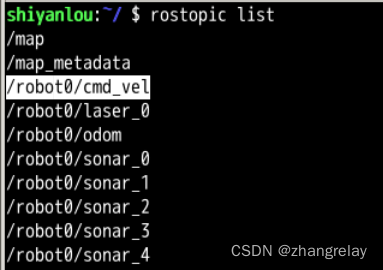ROS1云课→24机器人感知配置
移动机器人控制和运动学动力学模型密切相关。
差动驱动轮系统控制器。控制采用速度命令的形式,将其拆分然后发送到差动驱动轴距的两个车轮上。里程计是从硬件的反馈中计算出来的,并发布。如果仿真就简单了很多。
参考如下(机器翻译):

带转向机构的车轮系统控制器。控制采用速度命令的形式,该命令被拆分然后发送到转向驱动轮座的单个后轮和单个前转向。里程计是从硬件的反馈中计算出来的,并发布。
创建基础控制器
对于导航功能包集来说,一个基础控制器是非常重要的,因为这是唯一能够有效地控制机器人的方法。它能够直接和机器人的电子设备通信。
ROS并不提供任何标准的基础控制器,因此必须自己编写针对移动平台的基础控制器。
机器人通过geometry_msgs/Twist类型的消息进行控制。这个类型正是之前看到的Odometry消息所使用的。
所以基础控制器必须订阅名称为cmd_vel的主题,必须生成正确的线速度和角速度命令来驱动平台。
现在先复习一下消息的结构。在命令行窗口内输入以下命令查看消息的具体结构:
$ rosmsg show geometry_msgs/Twist
这个命令的输出结果如下所示:

二维环境控制:
geometry_msgs/Vector3 linear float64 x float64 y float64 z geometry_msgs/Vector3 angular float64 x float64 y float64 z
三维环境控制:
geometry_msgs/Vector3 linear float64 x float64 y float64 z geometry_msgs/Vector3 angular float64 x float64 y float64 z
其中,线速度向量linear包含了x、y和z轴的线速度。角速度向量angular包含了各个轴向的角速度。
两轮差速结构(diff):
diff-drive-controller
对于两轮机器人,只需要使用线速度x和角速度z。这是因为机器人基于差动轮驱动平台,驱动它的两个电动机只能够让机器人前进、后退或者转向。
车式转向结构(ackermann):
rosmsg show ackermann_msgs/AckermannDrive [21:27:00]
float32 steering_angle
float32 steering_angle_velocity
float32 speed
float32 acceleration
float32 jerkmobile_base_controller: type : "ackermann_steering_controller/AckermannSteeringController" rear_wheel: 'rear_wheel_joint' front_steer: 'front_steer_joint' publish_rate: 50.0 # default: 50 pose_covariance_diagonal : [0.001, 0.001, 1000000.0, 1000000.0, 1000000.0, 1000.0] twist_covariance_diagonal: [0.001, 0.001, 1000000.0, 1000000.0, 1000000.0, 1000.0]Wheel separation between the rear and the front, and diameter of the rear.
These are both optional.
ackermann_steering_controller will attempt to read either one or both from the
URDF if not specified as a parameter.
wheel_separation_h : 1.0
wheel_radius : 0.3Wheel separation and radius multipliers for odometry calibration.
wheel_separation_h_multiplier: 1.0 # default: 1.0
wheel_radius_multiplier : 1.0 # default: 1.0Steer position angle multipliers for fine tuning.
steer_pos_multiplier : 1.0
Velocity commands timeout [s], default 0.5
cmd_vel_timeout: 0.25
Base frame_id
base_frame_id: base_footprint #default: base_link
Odom frame_id
odom_frame_id: odom
Velocity and acceleration limits
Whenever a min_* is unspecified, default to -max_*
linear:
x:
has_velocity_limits : true
max_velocity : 1.0 # m/s
min_velocity : -0.5 # m/s
has_acceleration_limits: true
max_acceleration : 0.8 # m/s^2
min_acceleration : -0.4 # m/s^2
has_jerk_limits : true
max_jerk : 5.0 # m/s^3
angular:
z:
has_velocity_limits : true
max_velocity : 1.7 # rad/s
has_acceleration_limits: true
max_acceleration : 1.5 # rad/s^2
has_jerk_limits : true
max_jerk : 2.5 # rad/s^3
如何在地图中移动机器人呢?
两轮差动cmd_vel。

使用rqt


如果需要自动避障参考:
/******************************************************************************
STDR Simulator - Simple Two DImensional Robot Simulator
Copyright (C) 2013 STDR Simulator
This program is free software; you can redistribute it and/or modify
it under the terms of the GNU General Public License as published by
the Free Software Foundation; either version 3 of the License, or
(at your option) any later version.
This program is distributed in the hope that it will be useful,
but WITHOUT ANY WARRANTY; without even the implied warranty of
MERCHANTABILITY or FITNESS FOR A PARTICULAR PURPOSE. See the
GNU General Public License for more details.
You should have received a copy of the GNU General Public License
along with this program; if not, write to the Free Software Foundation,
Inc., 51 Franklin Street, Fifth Floor, Boston, MA 02110-1301 USAAuthors :
- Manos Tsardoulias, etsardou@gmail.com
- Aris Thallas, aris.thallas@gmail.com
- Chris Zalidis, zalidis@gmail.com
******************************************************************************/include "stdr_samples/obstacle_avoidance/obstacle_avoidance.h"
/**
@namespace stdr_samples
@brief The main namespace for STDR Samples
/
namespace stdr_samples
{
/
@brief Default contructor
@param argc [int] Number of input arguments
@param argv [char **] Input arguments
@return void
**/
ObstacleAvoidance::ObstacleAvoidance(int argc,char **argv)
{
if(argc != 3)
{
ROS_ERROR(
"Usage : stdr_obstacle avoidance <robot_frame_id> <laser_frame_id>");
exit(0);
}
laser_topic_ = std::string("/") +
std::string(argv[1]) + std::string("/") + std::string(argv[2]);
speeds_topic_ = std::string("/") +
std::string(argv[1]) + std::string("/cmd_vel");subscriber_ = n_.subscribe( laser_topic_.c_str(), 1, &ObstacleAvoidance::callback, this); cmd_vel_pub_ = n_.advertise<geometry_msgs::Twist>(speeds_topic_.c_str(), 1);}
/**
@brief Default destructor
@return void
**/
ObstacleAvoidance::~ObstacleAvoidance(void)
{}
/**
@brief Callback for the ros laser message
@param msg [const sensor_msgs::LaserScan&] The new laser scan message
@return void
**/
void ObstacleAvoidance::callback(const sensor_msgs::LaserScan& msg)
{
scan_ = msg;
float linear = 0, rotational = 0;
for(unsigned int i = 0 ; i < scan_.ranges.size() ; i++)
{
float real_dist = scan_.ranges[i];
linear -= cos(scan_.angle_min + i * scan_.angle_increment)
/ (1.0 + real_dist * real_dist);
rotational -= sin(scan_.angle_min + i * scan_.angle_increment)
/ (1.0 + real_dist * real_dist);
}
geometry_msgs::Twist cmd;linear /= scan_.ranges.size(); rotational /= scan_.ranges.size(); //~ ROS_ERROR("%f %f",linear,rotational); if(linear > 0.3) { linear = 0.3; } else if(linear < -0.3) { linear = -0.3; } cmd.linear.x = 0.3 + linear; cmd.angular.z = rotational; cmd_vel_pub_.publish(cmd);
}
}